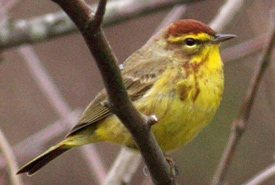Thanks Canada, Thanks Virgina - The warblers have returned to Florida!

Palm warbler (Photo by Marshall Faintich)
As October draws to a close, so does the fall migration season. Billions of birds, including the colourful, neotropical warbler varieties, have journeyed thousands of miles from summer breeding grounds in the north to winter haunts in the south; many will even remain in Florida for the colder months before spring migration.
As Robert Winkler writes for National Geographic News, “of the 115 wood-warbler species in this strictly New World tribe, about 60 range north of Mexico,” returning again in the winter. During the high traffic periods of spring and fall migration, birders can hope to scout at least the 30 regularly found along the eastern seaboard.
Though the warblers weigh less than an ounce, they can fly for days at a time, nonstop over the Atlantic Ocean. In one study, a prothonotary warbler traveled 8,050 kilometres in an eight-month period. Given their small size, such annual journeys are nothing short of miraculous.
This has been a banner year for bird species, complete with new and ongoing partnerships as well as the 100th year celebration of the Migratory Bird Treaty. Read more below about how these initiatives are aiding warblers in their international journeys!
International Conservation Partnerships
Migratory Bird Joint Ventures – Partnerships work across political and national boundaries to implement landscape-scale conservation. Throughout Canada, the United States and Mexico, joint ventures have protected 24 million acres and worked with over 5,000 partners.
The North American Bird Conservation Initiative (NABCI) Committee – Working in Canada, the United States and Mexico, the committee aims to advance priorities in bird conservation through multiple subcommittees, including: communications, the executive council, human dimensions, international efforts, monitoring, private and working lands and producing the State of the Birds report. For example, they have worked with land trusts to promote bird conservation on a regional scale and national scale.
The Neotropical Migratory Bird Conservation Act – Now in its 14thyear, the program has awarded over $50 million in grants, 75 per cent of which must support activities outside the United States. The grants have funded over 450 projects in 36 countries; see examples below.
100 Years of the Migratory Bird Treaty
The treaty, first signed in 1916 and passed by Congress in 1918, protected bird species hovering near extinction after decimation through hunting or the hat-feather trade. Now in its 100th year, the U.S. Fish and Wildlife Service (USFWS) wants to strengthen the implementation of the treaty in light of modern risks to birds, including windmills, power lines and cell phone towers.
As part of their centennial campaign, the USFWS worked with partners to create awareness of migratory bird conservation, promoted citizen science initiatives and the purchase of the Federal Duck Stamp, and increased support for programs across the country and the world. Read more here.
One Sky Our Birds Blogs
Since the spring, we have heard from authors across the Atlantic Flyway as they birded for warblers during long journeys to and from breeding grounds. From Florida to Virginia to Canada and back again, we have traced the adventures of these aerial ambassadors, while highlighting activities each and every one of us can undertake to improve bird survival during migration.
This blog post is one in a series of posts from an international blog exchange celebrating the conservation of migratory birds.


